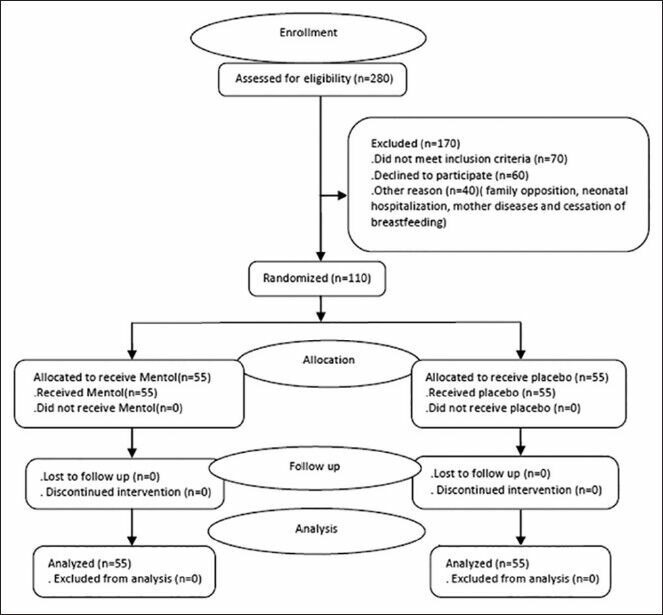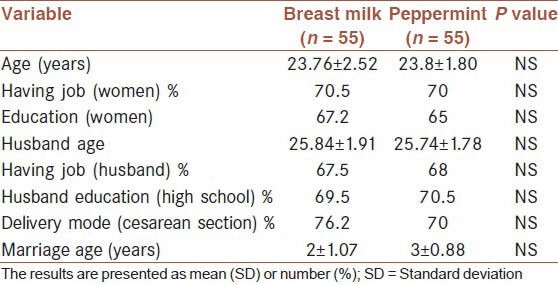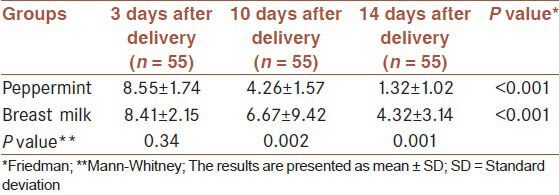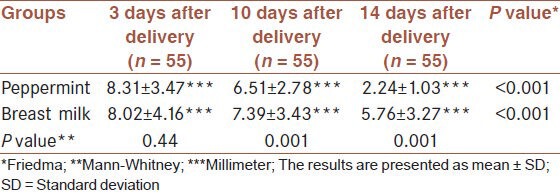Abstract
Background:
Nipple fissure is a common disorder during breastfeeding. With high prevalence of nipple fissures and its impacts on breastfeeding, as well as the existence of evidence in favor of the application of peppermint as an antiinflammatory and antiinfection herb, the purpose of this study is to determine the effect of Menthol essence on improving nipple fissures in the primiparous breastfeeding women.
Materials and Methods:
This study was conducted using a clinical trial method. Samples were divided randomly into two groups of 55 women. The women in the peppermint group applied four drops of Menthol essence on their nipple and areola after each feeding. The control group applied four drops of their own milk on the nipple and areola after each feeding. Then, the two groups were studied on days 10 and 14 postpartum. For intensity of pain, the visual analog scale (0-10 cm) and to measure the severity of damage, Amir scale (1-10 cm) were applied and the existence or lack of nipple discharge was also recorded. The data were analyzed using SPSS 17 software.
Results:
The mean intensity of pain and nipple fissure before treatment (8.55 ± 1.74) and day 10 after delivery (4.26 ± 1.57) and before treatment and day 14 after delivery in the case group (1.32 ± 1.02) had a significant difference (P < 0.001). Nipple discharge between the two groups, before treatment (%75.2) and day 10 after delivery (%31.6) and before treatment and day 14 after delivery (%15.7), the case group had a significant difference (P < 0.001).
Conclusion:
Menthol essence can improve nipple fissures in the primiparous breastfeeding women.
Keywords: Amir scale, menthol, nipple fissures, peppermint essence, visual analog scale
INTRODUCTION
Despite the fact that 98% of women are physiologically capable of breastfeeding, nowadays many mothers avoid breastfeeding after delivery. One of the most common causes of this problem is nipple fissure experienced by breastfeeding women in the 1st days after delivery and is the second leading cause of early termination of breastfeeding, the first being the feeling of inadequacy of milk by mothers, and the main reason to use bottle-feeding.[1] A nipple fissure is an injury on the nipple of breastfeeding women, which is accompanied by pain, inflammation and discharge. The highest incidence is between days 3 and 7 after delivery. In some women, it may take up to 6 weeks after delivery.[1] Since 1945, sore nipple has been reported in papers and recorded as a reason for ablactating of infants by mothers.[2] According to the reports in the papers, 80% of breastfeeding mothers experience nipple pain and injury which interfere with breastfeeding.[2] Of the causes of nipple pain and damage, reference can be made to inappropriate breastfeeding techniques and bad positioning of the infant, which results in stretching the newborn makes to remove the nipple, especially in the 1st day after birth when the mother lacks enough milk and repeated sucking occurs. Untreated nipple fissure can cause such problems as severe pain and bleeding.[1] Nipple fissures can act as a portal for bacteria and can lead to mastitis.[3] Creams, lotions, and ointments are used for prevention and treatment of nipple fissures, none of which has any scientific basis.[4] Due to having anti-inflammatory and anti-microbial substances, breast milk is also used in preventing and improving nipple fissures.[1] Renfrew et al. have stated that there is no topical medicine for the prevention and treatment of nipple fissures.[5] Some studies have suggested that application of ointments may be unnecessary and costly.[6] In recent years, due to the failure of existing therapies researchers have inclined to use herbal medicines. Today, herbs like peppermint, Aloe vera, meadowsweet and hypericum are used widely throughout the world and sale of medicinal herbs has increased exponentially.[7] One of the plants used in long ago is peppermint with the scientific name of menthe piperitha. Of its medicinal properties, antispasmodic properties, including antivomiting and cooling can be mentioned.[8] Peppermint is one of the world's most consumed medicinal plants with annual consumption of about 7000 tons. Menthol essence has an ingredient called Menthol whose antimicrobial activity on microorganisms has been identified.[9] Menthol essence (Menthol) affects the cell membrane. These compounds attack the cytoplasmic membrane of microorganisms and inflammatory factors and degrade their membrane, leading to release of intracellular components (ribose, sodium glutamate, etc.). In addition, it plays a role in degradation of electron transfer activity, absorption of nutrients, nucleic acid synthesis and Atpase enzyme activity, which in turn leads to protection of cells and loss of microorganisms and thus prevention of damage to the tissue cells.[10] In studies conducted using the essence of this herb no complications, adverse effects or allergies has been reported. It is considered safe even in pregnancy and lactation. It is classified in group (A) in Australia and permitted by the American Food and Drug Administration to be added to foods category.[11,12] Accordingly, this study was designed to evaluate the effect of Menthol essence in treatment of nipple fissure in the primiparous breastfeeding women visiting healthcare centers of Tehran during 2011-2012.
MATERIALS AND METHODS
In this clinical trial study, effects of menthol essence and breast milk on the improvement of nipple fissures in breastfeeding women were investigated. The study was held during September 2010 until November 2011. Participants of the study were all lactating women with nipple fissures who visited the selected healthcare centers of Shahid Beheshti University of Medical Sciences on their 3rd day after delivery. All parturient women should have visit in health care centers for their newborn's thyroid screening tests as a routine national program in Iran. The inclusion criteria was having term pregnancy, singleton neonate, and lack of abnormality in breasts and being primiparous. Women who had postpartum fever or breast infection (mastitis) or their newborns had oral infections, and infants with Short Frenulum tongue were excluded [Figure 1].
Figure 1.

Flow of participants through the clinical trial study
The sample was estimated to be 110 people, with 95% of confidence level and an error probability of 5%. First, the study purpose and the conduction manner were explained to lactating women. If they consented to participate in the study, their written informed consent was taken. () Random allocation was done based on random numbers table. Women who participating in the study were divided in two groups of peppermint and control (placebo) data were collected applying an observational checklist in order to examine the intensity of nipple damage and presence of purulent secretion of fissure. The Amir scale[13] for severity of damage was used to determine the severity of nipple damage and visual analog scale for pain intensity was used to measure the pain. Obstetric and demographic characteristics of participants were collected with a researcher made questionnaire.
For each group, 50 people were considered and with a 10% probability of determent, the number was increased to 55 people for each group. Therefore, the study was conducted on a total number of 110 lactating women. In the first phase before treatment, the first part of the check list was filled out and the check list 2 and 3 related to pain, injury rate of nipple and the existence of nipple discharge were completed in two stages (days 10 and 14 postpartum) by the researcher.
In order to determine the validity and reliability of the data form, content validity and test-retest techniques were applied respectively and r was estimated 0.9 (r = 0.9). The pain was measured using visual analog scale (over the 10 cm tape). In this scale, numbers 1-3 reflects mild pain, 4-7 moderate pain and 8-10 represents severe pain. To check the amount of damage of the nipple and areola, Amir et al. scale was applied. Based on this scale 1-2 mm reflects minor, 3-9 mm medium, and 10 mm and more represents severe damage.
Menthol essence in the form of Menthol drop that is produced by Poursina Co. in 15 mL packages was used. The women in the peppermint group were asked to apply 4 drops of Menthol essence on the nipple and areola after each feeding (every 2 h). The women in the control group were requested to apply 4 drops of their own milk on their nipple and areola after each feeding. The participants in both groups were asked to refer to relevant center on days 10 and 14 after delivery to check the severity of pain, injury and nipple discharge. If any women refused to attend the center for any reason, a researcher would visit them at their homes and would examine their fissures.
In this study, the data have been analyzed using version 17 of the SPSS software (IBM Corporation, NY, USA). Descriptive statistical methods including frequency distribution table, mean index, and standard deviation were used to describe the individual characteristics of the subjects. Then, with due consideration to the ranking nature of the response variable and the abstract nature of the data, first the intensity of pain and severity of damage during 3 days were compared using Friedman test. The responses (results) of medicine and placebo groups were compared using Mann-Whitney test. In addition, in cases where the Mann-Whitney test was significant, cycles of treatment were compared two-by-two with alpha correction using Wilcoxon test. The significance was considered level 0.05. For examining nipple discharge, the existence or lack of discharge in 3 days was compared using Cochran test. Then, the responses of the medicine and placebo groups were compared using Chi-square test.
RESULTS
The study was conducted on 110 primiparous lactating women with nipple fissures in two groups of medicine and placebo with 55 people in each group. The two groups were homogeneous in terms of age, education, duration of pregnancy, and delivery method meaning that the members of the two groups did not have a significant difference in these regards [Table 1].
Table 1.
Comparison of demographic and midwifery characteristics of the peppermint and breast milk groups in the primiparous lactating women

In comparison of the difference in pain intensity score before treatment and day 10 after delivery, as well as the pain intensity score before treatment and day 14 after delivery, the two groups showed a statistically significant difference [Table 2].
Table 2.
Comparison of pain intensity before and after treatment in the peppermint and breast milk groups (mean ± SD) in the primiparous lactating women

In comparison of the difference in damage severity score in two groups, damage severity score before treatment and day 10 after delivery, as well as damage severity score before treatment and day 14 after delivery, the peppermint and breast milk groups showed a statistically significant difference [Table 3].
Table 3.
Comparison of nipple fissure damage severity before and after treatment in the peppermint and breast milk groups (mean ± SD) in the primiparous lactating women

In comparison of the difference in the existence or lack of nipple discharge before treatment and day 10 after delivery, as well as the pain intensity score before treatment and day 14 after delivery, the two groups of peppermint and breast milk showed a statistically significant difference [Table 4].
Table 4.
Comparison of nipple fissure discharge before and after treatment in the peppermint and breast milk groups (mean ± SD) in the primiparous lactating women

DISCUSSION
The findings of this study indicated that Menthol essence (Menthol) improves nipple fissures. In a study conducted by Melli et al. in 2007 under the title of “The Effect of Peppermint water in the Prevention of Nipple fissures,” the results suggested that nipple fissures in the intervention group were significantly fewer than those in the control group (relative risk = 3.6, 95% confidence interval = 2.4-4.3). The results of that study were consistent with those of our study. However in Sayah's study, Menthol essence has been used in the prevention of nipple fissures so that all women in case group had received Menthol essence from the very 1st day after delivery, while in the present study Menthol essence was used as a medicine for treatment of nipple fissures. Moreover, Melli et al.[14] conducted another study in 2007 for examining the effects of peppermint gel, lanolin ointment and placebo gel on the prevention of nipple fissures. The results of that study were also consistent with those of our study. Sayah's study indicated that the incidence of nipple fissures in the group receiving peppermint was lower than that of other groups (P < 0.001).
In conducted surveys, no similar studies in which peppermint herb is used for treatment of nipple fissures were found but researchers have tried peppermint in other cases of inflammation and infection. For instance, Willis et al.[15] suggest that Menthol essence (Menthol) reduces inflammation of respiratory tracts and prevents stimulating effects of nicotine on smokers. Menthol interferes with the functioning of transient receptor potential Melastatin-8 (TRPM8) and Ankirin-1 (TRPA1) receptors and the stimulation channels; and this reduces inflammation in the tissue. Willis et al. claimed, inter alia, that Menthol reduces inflammation in smokers’ respiratory tracts through interfering in the functioning of inflammation receptors (TRPM8) and (TRPA1). Alvandi et al.[16] suggested that Menthol essence (Menthol) has strong anti-microbial effects and that this property is more effective on Gram-positive bacteria than Gram-negative ones. Alvandi et al. also stated that, through affecting the microbes’ plasma membrane and increasing the amount of some specific ions on or inside the membrane, Menthol has a wide-range impact on protons’ driving force, the intracellular adenosine triphosphate and the whole activity of microbial cells including pressure control of living cells, and transport of soluble materials, and regulating metabolism). Menthol also prevents bacteria growth. Deans and Ritchi[17] have also expressed that Menthol has strong antimicrobial properties particularly on Gram-positive bacteria. They stated that Gram-positive bacteria are more sensitive to the antibacterial action of Menthol and that lower sensitivity of Gram-negative bacteria is perhaps due to the external membrane of Gram-negative bacteria, which limits the hydrophobic diffusion of the essence to the lipo-polysaccharide layer of the cell. Nipple fissure due to poor sucking by the infant is a suitable environment for bacterial colonization especially infants’ oral flora. This increases the risk of parenchymal infection of breasts (mastitis) and breast abscess after fissure. Menthol essence (Menthol) attacks cytoplasmic membrane of microorganisms and inflammatory agents and destroys the membrane. This leads to release of intracellular components (ribose, sodium glutamate, etc.). It can also protect the cells and destroy microorganisms and thus prevent damage to tissue cells due to its role in degradation of electron transport process, nutrients absorption, synthesis of nucleic acid, and Atpase enzyme activity.[18]
AUTHORS’ CONTRIBUTIONS
SAAA carried out the design and coordinated the study, participated in most of the experiments and prepared the manuscript. SHA provide assistance in the design of the study, coordinated and carried out all the experiments and participated in manuscript preparation. AAB and PM provided assistance for all experiments. All authors have read and approved the content of the manuscript.
ACKNOWLEDGMENTS
This paper is the result of a research project by Shahid Beheshti University of Medical Sciences. Hereby, we appreciate the Chancellor, Vice Chancellor and the Research Affairs Department. We also sincerely thank all the ladies participated in the study and wish them good health given the fact that without their cooperation this study was not possible. Our thanks should also go to all physicians and midwives in the health centers-hospitals affiliated to Shahid Beheshti University of Medical Sciences for their cooperation with researchers in providing the necessary conditions for sample collection.
Footnotes
Source of Support: This study is funded by Shahid Beheshti University of Medical Sciences (Research project Number 25/12/566) IRCT number: IRCT201206166807N5
Conflict of Interest: None declared.
REFERENCES
- 1.Cunningham FG, Leveno KJ, Bloom SL, Hauth JC, Rouse DJ, Spong CY, et al. New York: MCGraw Hill; 2010. Williams Obstetrics. [Google Scholar]
- 2.Sayyah Melli M, Rashidi MR, Delazar A, Madarek E, Kargar Maher MH, Ghasemzadeh A, et al. Effect of peppermint water on prevention of nipple cracks in lactating primiparous women: A randomized controlled trial. Int Breastfeed J. 2007;2:7. doi: 10.1186/1746-4358-2-7. [DOI] [PMC free article] [PubMed] [Google Scholar]
- 3.Goerg KJ, Spilker T. Effect of peppermint oil and caraway oil on gastrointestinal motility in healthy volunteers: A pharmacodynamic study using simultaneous determination of gastric and gall-bladder emptying and orocaecal transit time. Aliment Pharmacol Ther. 2003;17:445–51. doi: 10.1046/j.1365-2036.2003.01421.x. [DOI] [PubMed] [Google Scholar]
- 4.Page T, Lockwood C, Guest K. Management of nipple pain and/or trauma associated with breast-feeding. JBI Rep. 2003;1:127–47. doi: 10.11124/01938924-200301030-00001. [DOI] [PubMed] [Google Scholar]
- 5.Renfrew MJ, Woolridge MW, Ross McGill H. London: The Stationary Office; 2000. Enabling Women to Breastfeed. [Google Scholar]
- 6.Pugh LC, Buchko BL, Bishop BA, Cochran JF, Smith LR, Lerew DJ. A comparison of topical agents to relieve nipple pain and enhance breastfeeding. Birth. 1996;23:88–93. doi: 10.1111/j.1523-536x.1996.tb00835.x. [DOI] [PubMed] [Google Scholar]
- 7.Ebadi M. 1st ed. London: CRC Press; 2001. Pharmacodynamic Basis of Herbal Medicine. [Google Scholar]
- 8.Iþcan G, Kirimer N, Kürkcüoğlu M, Başer KH, Demirci F. Antimicrobial screening of Mentha piperita essential oils. J Agric Food Chem. 2002;50:3943–6. doi: 10.1021/jf011476k. [DOI] [PubMed] [Google Scholar]
- 9.Tylor VE. Binghamton: Pharmaceatrial Products Press; 1993. The Honest Herbal. [Google Scholar]
- 10.Guedon DJ, Pasguier BP. Analysis and distribution of flavonoid glycosides and rosmarinic acid in 40 Mentha x piperita clones. L. Agric Food Chem. 1994;42:679–84. [Google Scholar]
- 11.de Smet P. Adverse effects of herbal medicines. In: Tafaghodi M, Amiri R, Hossein Zadeh H, translators. 1st ed. Mashhad: Mashhad University of Medical Sciences; 2006. p. 220. [Google Scholar]
- 12.Barnes J, Anderson LA, Phillipson JD, Newall CA. 2nd ed. London: Pharmaceutical Press; 2002. Herbal Medicines: A Guide for Healthcare Professionals; p. 468. [Google Scholar]
- 13.Amir LH, Lumley J, Garland SM. A failed RCT to determine if antibiotics prevent mastitis: Cracked nipples colonized with Staphylococcus aureus: A randomized treatment trial [ISRCTN65289389] BMC Pregnancy Childbirth. 2004;4:19. doi: 10.1186/1471-2393-4-19. [DOI] [PMC free article] [PubMed] [Google Scholar]
- 14.Melli MS, Rashidi MR, Nokhoodchi A, Tagavi S, Farzadi L, Sadaghat K, et al. A randomized trial of peppermint gel, lanolin ointment, and placebo gel to prevent nipple crack in primiparous breastfeeding women. Med Sci Monit. 2007;13:CR406–411. [PubMed] [Google Scholar]
- 15.Willis DN, Liu B, Ha MA, Jordt SE, Morris JB. Menthol attenuates respiratory irritation responses to multiple cigarette smoke irritants. FASEB J. 2011;25:4434–44. doi: 10.1096/fj.11-188383. [DOI] [PMC free article] [PubMed] [Google Scholar]
- 16.Alvandi K, Sharifan R, Aghazadeh A, Meshghi M. Study of chemical composition and antimicrobial activity of peppermint essential oil. Journal of Comparative Pathobiology. 2010;7:355–64. [Google Scholar]
- 17.Deans SG, Ritchi G. Antibacterial properties of plant essential oils. Int J Food Microbiol. 1997;5:165–80. [Google Scholar]
- 18.Morland-Schultz K, Hill PD. Prevention of and therapies for nipple pain: A systematic review. J Obstet Gynecol Neonatal Nurs. 2005;34:428–37. doi: 10.1177/0884217505276056. [DOI] [PubMed] [Google Scholar]


